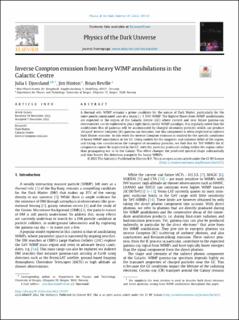Inverse Compton emission from heavy WIMP annihilations in the Galactic Centre
Journal article, Peer reviewed
Published version

Åpne
Permanent lenke
https://hdl.handle.net/11250/3127062Utgivelsesdato
2023Metadata
Vis full innførselSamlinger
Sammendrag
A thermal relic WIMP remains a prime candidate for the nature of Dark Matter, particularly for the more poorly constrained case of a heavy ( 1 TeV) WIMP. The highest fluxes from WIMP annihilations are expected in the region of the Galactic Centre (GC) where current and near future gamma-ray observatories can be exploited to place tight limits on the WIMP paradigm. It is regularly noted that the annihilation flux of gammas will be accompanied by charged secondary particles which can produce ‘delayed’ inverse Compton (IC) gamma-ray emission, but this component is often neglected in indirect Dark Matter searches. In this work the inverse Compton emission is studied for the specific conditions of heavy WIMP annihilation in the GC. Using models for the magnetic and radiation fields of the region, and taking into consideration the transport of secondary particles, we find that for TeV WIMPs the IC component cannot be neglected in the GC, with the particles produced cooling within the region rather than propagating out in to the Galaxy. This effect changes the predicted spectral shape substantially and thus boosts the detection prospects for heavy WIMPs.
